| MgO | 40.0%-43.5% |
| CaO | 0.6% Max |
| Fe | 0.2% Max |
| Moisture | 3.0 % Max |
| Loss on burn | 56% Max |
| Sulphate | 0.2% Max |
| Chloride | 0.1%Max |
| HCL-insoluble matter | 1% Max |
| Mn | 0.005% Max |
| Sieve residue | 0.05% Max |
- Home
- Products
- magnesium carbonate chalk for gymnastics and rock climbing, weightlifting and bowling and other sports non-slip sports
magnesium carbonate chalk for gymnastics and rock climbing, weightlifting and bowling and other sports non-slip sports
Introducing our versatile non-slip sports chalk, perfect for gymnastics, rock climbing, weightlifting, bowling, and more. As a factory, we guarantee high-quality magnesium carbonate chalk for optimal grip and performance.
Request a QuotePRODUCTS DETAILS
Hot Products

Galvanization grade Tartaric Acid

Qualitative filter paper; diameter 9cm

Amphiprotic surfactant BS-12

Polyisocyanate adhesive

anthracene C14H10

Magnesium sulfate anhydrous white powder

Water Treatment Chemical Poly Aluminium Chloride (pac) 30%

sodium dichloroisocyanurate 200g tablet

Quantitative filter paper for experiment

3% water-forming foam fire extinguishing agent
Contact us
Please feel free to give your inquiry in the form below We will reply you in 24 hours


